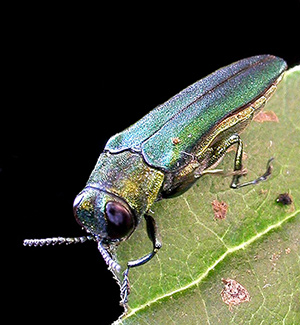
The beautiful, but deadly, emerald ash borer (EAB) doesn’t look to be slowing down. In fact, this army of tree pests is taking its attack on ash trees global.
Last month, four Russian scientists — three from Moscow and one from Siberia — paid a visit to the U.S. to learn more about a pest that has recently become all-too-familiar to them. Yury Ivanovich Gninenko and Yulia Anatolievna Sergeeva, researchers in forest protection against invasive insects from the Russian Research Institute for Silviculture and Mechanization of Forestry (VNIILM) in Moscow were joined by forester Aleksandr Evgenievich Droskov and head of the V.N. Sukachev Institute of Forest’s Department of Forest Zoology in Krasnoyarsk, Siberia, Yuri Baranchikov, for a two-week trip to the U.S. that was less about seeing the sights and more about delving into information about the emerald ash borer. After attending a conference on invasive forest pests in Maryland and stopping by some East Coast laboratories, they headed to Michigan State University (MSU), where American Forests Science Advisory Board member and forest entomologist Dr. Deborah McCullough and her colleagues have been devoting a lot of energy to studying these critters.
MSU is a logical choice for a trip revolving around EAB. Since EAB was first identified in Detroit, Mich., in 2002, the state has been one of the hardest hit by EAB. Now, it looks as if the Moscow area is heading down a similar path.
According to the researchers, EAB is now killing ash trees in Moscow at an alarming rate. While EAB is native to far eastern parts of Russia, the insect had to travel 11 time zones across the largest country in the world to get to Moscow, likely by way of the Trans-Siberian Railroad or Highway. That’s quite a journey for a little bug, and it means that Moscow’s trees are totally unfamiliar with this new threat.
Even more foreboding is that Moscow lies just 280 miles from western Europe, whose ash species have all been determined to be vulnerable to EAB. At this rate, says McCullough, it “won’t be long until EAB has circumnavigated the whole northern hemisphere.” Yikes!
The future of ash trees may look grim, but for those that want to do more than despair, there are ways you can help. Learn what you can do in the fight against EAB.